Ad:This post is part of my collaboration with Lovegrass Ethiopia who have gifted me some of their teff flour to experiment with. They will in turn share my content and gluten-free bread course on their page. My opinions are my own and I would use their products without the collaboration, too. I love their teff products and company ethos and have used their products already for a couple of years, which actually brought this collaboration about.
If you are wondering what on Earth is whipped porridge, I do not blame you! Whipped porridge is a Finnish mix of healthy porridge and dessert with berries added in. You whip it with a (preferably electric) whisk so that it resembles more an airy mousse than a porridge.
The porridge is traditionally made with semolina which obviously is wheat and not ok for gluten-free diet. You could make yours with gluten-free semolina, which is usually made with corn. As I can not eat corn, I have created an alternative which also has a higher amount of fibre and minerals with Lovegrass Ethiopia’s teff grain, which is guaranteed to be gluten-free. You can use also other brands of teff grain, after checking that they haven’t got a ‘may contain’ warning for gluten, when you need to make sure it’s suitable for people with coeliac disease to eat. If you want to learn more, why I love Lovegrass Ethiopia’s grain so much, you can read about it in my previous post about teff spinach pancakes.
The porridge is simple enough to make – all you need is teff grain, some sort of berries or fruit, water, milk (or dairy-free alternative), salt and some sugar. You can also swap fruit with cocoa powder and make chocolate porridge, I will share the recipe of that, too. For shortest cooking time, pre-soak the teff grain overnight and use a regular saucepan. If you want the milk-based porridge not to catch the bottom of the saucepan, you can use a tiered steamer to cook the porridge in a bain Marie. On a gas hob it is a good idea to use a heat distribution plate under the saucepan if you are cooking a milk-based porridge.

Whipped Teff Porridge Recipe
The recipe makes two generous portions of porridge. You get the best result if you soak the teff grain overnight in water, as then you get the grain as soft as possible without extensive cooking. In a saucepan this porridge takes 15-20min to cook when the grain is pre-soaked, when you use a tiered saucepan, the cooking time is roughly double. This recipe is for the berry porridge and you can find additional instruction for the chocolate porridge further down.
Ingredients:
| 125 ml (1/2 cup, 100g) | Whole teff grain (brown or white). I use Lovegrass Ethiopia |
| 165 ml (3/4 cup, 165g) | Water |
| 250 ml (1 cup, ~250g) | Milk (preferably semi-skimmed or full fat) or GF dairy-free milk alternative |
| 1/2 tsp (2g) | Salt |
| 250ml (1 cup, 75-100g) | Berries either fresh or defrosted frozen ones (I used Summer fruits) |
| 1-2 tbsp (5-10g) | Granulated sugar (optional, according to taste) |
Method:
- Mix the whole teff grain and water in the saucepan you plan to use (either a regular saucepan or in a tiered steamer). Let soak overnight or preferably minimum of two hours.
- After soaking either put the saucepan on the hob with medium heat or place the tiered steamer pot on top of the bottom tier with water half-way filled and place on medium high heat and turn down when the water at the bottom tier starts boiling. Put the lid on if you have one.
- After 10-15min the teff grain should have soaked up all the water. At this point add the milk and salt in and mix until smooth.
- Cook for an extra 10-25min depending on the cooking method until the teff grain should feel quite smooth and soft. There will always be some texture left as the grain won’t turn completely soft due to the high fibre content.
- Purée the berries you are using by pressing them through a sieve. Do this especially if you are using berries with large seeds in so that they do not distrub the texture of the porridge*. Add some sugar in, if the purée is sharp. Mix the puree into the porridge and whip with either an electric whisk or stick blender (in a pinch a balloon whisk with some muscle will do) until you have an airy smooth porrige. (*If you are using a stick blender and are using berries with small seeds or seedless pieces of fruit) you can mix the berries/fruit into the porridge prior blending it saving yourself a job. If you don’t mind the seeds in, you can get the full benefit of the berries with the skins in the porridge, as the skins hold a lot of the vitamins and other beneficial things.)
- Check the seasoning, add salt or sugar if needed. Serve the porridge either hot or cold with some more berries on top (when using frozen berries, add some more sugar to them as they can be quite tart), or a sprinkling of sugar and a splash of milk. The porrdge can be eaten as a breakfast, a nutritious snack or a dessert.
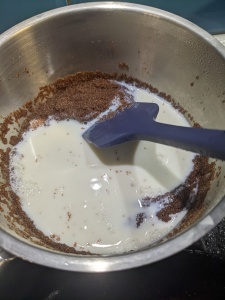

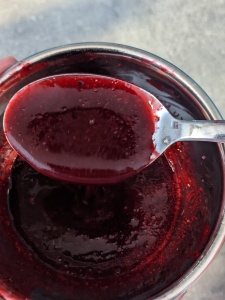
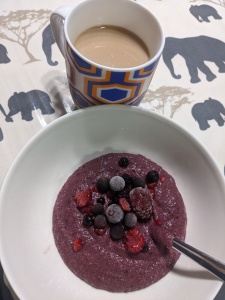
Having the skins of berries in the porridge gives more intense colour and you get all the berry goodness in as a lot of it is on the skins. If you don’t mind the seeds being in, blitz them in whole.
Making chocolate whipped porrige
Chocolate whipped porridge is a true childhood favourite of mine. It was eaten as a dessert with milk, and if you want an extra treat, you can have it with vanilla custard instead. The method of making the porridge is the same as the berry one, but you substitute berries with chocolate milk.
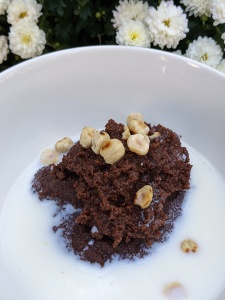
Chocolate porridge method
To make chocolate porridge, instead of using berries, use 2 tablespoons of dark cocoa powder (or cacao, you can use either, or even chocolate drink powder but then you might want to omit sugar or use less).
Mix the cocoa powder with a couple of splashes of milk and mix into a paste, then add the milk in 2 or three parts dissolving the cocoa in, this is to avoid lumps. If they still occur, sieve the chocolate milk before mixing it in the porridge after the water has absorbed in the teff.
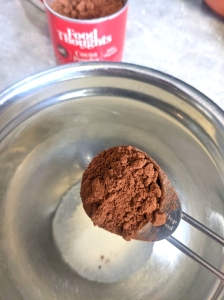
Cook for further 15-25min until soft (depending on the cooking method, saucepan or tiered steamer). You can even add a splash of vanilla extract in for extra flavour if you want! Whip the porridge when cooked using an electric whisk or stick blender (can also be done with a balloon whisk) . You can serve the porridge hot or cold with milk or custard for extra treat.
More interesting breakfast on the way
Personally I love using teff as the high fibre content makes me feel fuller for longer and my stomach seems to really appreciate it when I eat teff. If you don’t typically have a lot of high fibre foods, it might be a good idea to eat smaller portions of porridge and ease your gut in, in case your gut bacteria get a bit baffled with the new stuff. You can reheat the porridge adding some milk in and re-whipping until it’s smooth or eat it cold, then it’s more like a set pudding of sorts.
You can switch this recipe up by trying different fruits and berries and also experimenting with both white and brown teff. They are equally nutritious and have their own flavour characteristics. White teff is more mellow and feels slightly creamier in flavour and brown teff has delicious malty and even chocolatey notes that I love.
Hope this recipe is encouraging you to give teff grain a try! With the limitation of a gluten-free diet, we can’t really have too many options for tasty and nutritious breakfasts, snacks and desserts. Do comment here if you make this or come and find me on Instagram or Facebook, follow me and tag me in if you make this or some other recipe I have shared!

